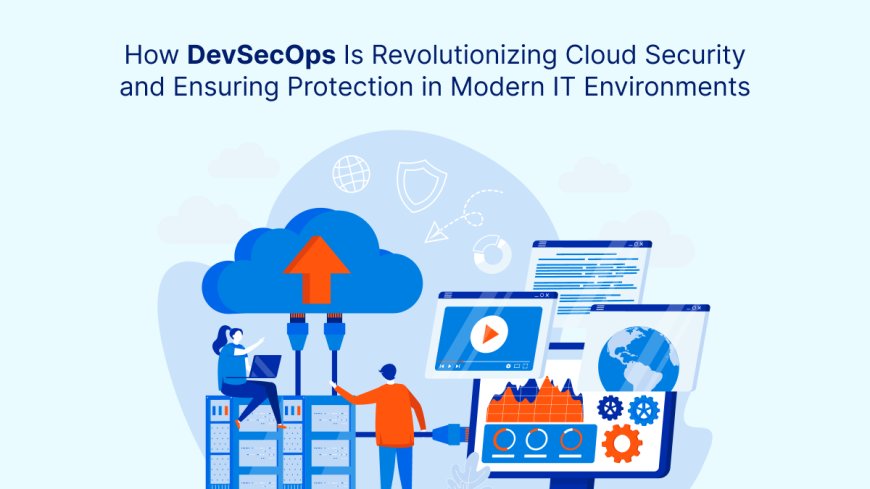How DevSecOps Is Revolutionizing Cloud Security and Ensuring Protection in Modern IT Environments?
Learn how DevSecOps is revolutionizing cloud security, ensuring protection and compliance in modern IT environments through automation and early threat detection.

The rise of cloud computing has changed how businesses operate, store data, and deliver services. While this digital transformation brings incredible benefits like scalability, speed, and cost savings, it also introduces serious security challenges. Traditional security models were never built for the pace and complexity of modern IT environments. Thats where DevSecOps comes ina powerful and modern solution that's transforming how organizations approach security in the cloud.
DevSecOps stands for Development, Security, and Operations. Its not just another buzzword. Its a practical way of working where security becomes part of the entire software lifecycle, not just an afterthought at the end. DevSecOps helps development teams build secure applications from day one, improves cloud protection, and ensures businesses stay compliant with regulations. In this blog, well explore how DevSecOps is revolutionizing cloud security and why its essential in todays fast-moving IT landscape.
Understanding DevSecOps
What Is DevSecOps?
DevSecOps is a cultural shift that blends security into every step of the software development process. In traditional setups, security checks happened only after development was finished, which often caused delays and allowed vulnerabilities to slip through. With DevSecOps, security is no longer a final checkpointits built-in from the beginning.
This means that developers write code with security in mind, automated tools scan for issues in real-time, and operations teams monitor systems continuously. Everyone is responsible for security, and the goal is to create safer software without slowing down progress.
Why DevSecOps Matters in Cloud Environments
Cloud platforms are fast, flexible, and complex. You can spin up servers, databases, or containers with just a few clicks. But that same speed can create security gaps if not managed properly. Misconfigured resources, open ports, or exposed APIs are all common risks in the cloud.
DevSecOps helps by keeping security aligned with cloud operations. It automates checks, flags issues early, and ensures that your infrastructure follows best practices. The result is stronger cloud security that keeps up with the pace of modern development.
Traditional Security vs. DevSecOps
The Old Way of Doing Things
In the past, security teams were separate from developers. Once the code was ready, it was handed over to security for review. If problems were found, the code had to go back, be fixed, and retested. This slowed everything down and caused frustration on all sides.
How DevSecOps Changes the Game
DevSecOps replaces that outdated model. It puts security tools into the hands of developers so they can catch issues as they write code. Security teams still play a role, but they act more like advisors, helping developers make better choices from the beginning. This approach saves time, reduces bugs, and leads to more secure applications.
Core Principles of DevSecOps in Cloud Security
Shift Left Security
The concept of "shift left" means moving security checks earlier in the development process. Instead of waiting until after the app is built, DevSecOps encourages checking for vulnerabilities during the design and coding stages. This makes it easier and cheaper to fix problems and helps create more reliable software.
Automation Is Key
Automation is a big part of DevSecOps. Security tools automatically scan code for vulnerabilities, test cloud infrastructure, and monitor systems in real-time. These tools work within the development pipeline so that no step gets skipped. This kind of automation speeds up development while keeping systems secure.
Continuous Monitoring
With DevSecOps, monitoring doesnt stop once the app is live. Systems are continuously watched for threats or strange behavior. If something unusual happens, alerts are sent instantly. This allows teams to respond quickly and prevent small issues from turning into big problems.
Collaboration Between Teams
DevSecOps encourages collaboration across development, operations, and security teams. Everyone shares responsibility and works together toward common goals. This culture of teamwork helps eliminate silos and creates more effective and secure systems.
Benefits of DevSecOps for Cloud Security
Faster Detection and Resolution
Because DevSecOps integrates security early in the process, it helps detect issues quickly. Instead of waiting for a security team to review everything later, developers get instant feedback. This reduces the time it takes to fix problems and leads to a faster, more secure release cycle.
Consistency Across Environments
Cloud environments are constantly changing. New services are added, resources are scaled, and configurations are updated. DevSecOps uses tools that manage these changes consistently and safely, making sure that the same security rules are applied everywhere.
Improved Compliance
Compliance with industry standards like GDPR, HIPAA, and PCI-DSS is a must for many businesses. DevSecOps automates compliance checks, ensuring that your cloud setup meets regulatory requirements at all times. It also keeps logs and audit trails that make it easier to show compliance during reviews or audits.
Reduced Risk of Human Error
A large number of security breaches are caused by human mistakesmisconfiguring a firewall, forgetting to encrypt data, or using weak passwords. DevSecOps uses automated tools to catch these kinds of issues before they become threats. It also provides guardrails so that teams dont accidentally make harmful changes.
DevSecOps Tools Commonly Used in the Cloud
Infrastructure as Code (IaC) Tools
Tools like Terraform or AWS CloudFormation allow teams to define cloud infrastructure using code. DevSecOps integrates security scans into these tools to ensure resources are deployed securely.
CI/CD Pipeline Tools
Platforms like Jenkins, GitLab CI, or GitHub Actions help automate the build and deployment process. DevSecOps adds security tests into these pipelines, so every code update is checked before its released.
Container Security Tools
In modern cloud apps, containers are everywhere. Tools like Aqua Security, Prisma Cloud, or Snyk help scan containers for vulnerabilities and protect them at runtime.
Cloud Security Platforms
Tools like AWS Security Hub or Azure Security Center provide centralized views of cloud security. DevSecOps integrates with these tools to track risks, enforce policies, and automate incident responses.
Read more:How DevSecOps Ensures Continuous Security and Compliance in Cloud Environments Today
Real-World Impact of DevSecOps
Stronger Cloud Defenses
Businesses that adopt DevSecOps report fewer security breaches and faster response times. By addressing risks early and automating checks, they stay one step ahead of attackers.
Scalable and Repeatable Security
As companies grow, they need systems that can scale. DevSecOps allows security practices to grow alongside the business. New projects automatically follow the same secure patterns, making expansion safer and simpler.
Better User Trust
When customers know that a business takes security seriously, they feel more confident. DevSecOps helps build that trust by ensuring data is protected and systems are reliable.
Improved Development Experience
Developers appreciate when they can write code without constantly being blocked by manual reviews. DevSecOps provides instant feedback through automation, helping developers build better software while staying secure.
Steps to Start with DevSecOps in Your Cloud Strategy
Start by evaluating your current development and security processes. Identify where delays happen and where risks are often missed. From there, choose one or two DevSecOps practices to implement, such as static code analysis or automated infrastructure scanning. Train your teams, adopt the right tools, and focus on collaboration. Over time, expand your efforts to cover more areas of your cloud environment.
Make sure to treat DevSecOps as a long-term journey, not a quick fix. Its about building a culture where everyone plays a role in keeping systems safe and compliant.
Conclusion
As cloud technology continues to evolve, businesses must evolve their approach to security too. DevSecOps is not just another toolsetits a complete transformation in how teams build, secure, and manage software in modern IT environments. By bringing security into the heart of development and operations, DevSecOps helps businesses stay ahead of threats, reduce risks, and meet the growing demands of compliance and trust. It ensures that security is no longer a barrier to innovation but a powerful part of it. For companies investing in digital growth or offering on demand app development services, adopting DevSecOps is a smart and necessary move toward safer and faster cloud development.
FAQs
What makes DevSecOps different from traditional DevOps?
While DevOps focuses on speed and collaboration between development and operations, DevSecOps adds security into the mix from the start. It ensures that security is part of the workflow, not an afterthought.
Can DevSecOps be used in any cloud platform?
Yes, DevSecOps practices can be used across all major cloud platforms like AWS, Azure, and Google Cloud. The tools and workflows are designed to be flexible and adaptable.
Do DevSecOps tools slow down development?
No, when implemented correctly, they actually speed things up. Automation allows security checks to happen in real time, reducing the need for manual reviews and last-minute fixes.
Is DevSecOps suitable for small companies?
Absolutely. Small businesses can benefit just as much as large enterprises. Many DevSecOps tools are open-source or budget-friendly, making them accessible to teams of all sizes.
How does DevSecOps help with regulatory compliance?
DevSecOps automates compliance checks, enforces security policies, and maintains detailed logs. This ensures that your systems stay compliant and makes it easier to prepare for audits.



























